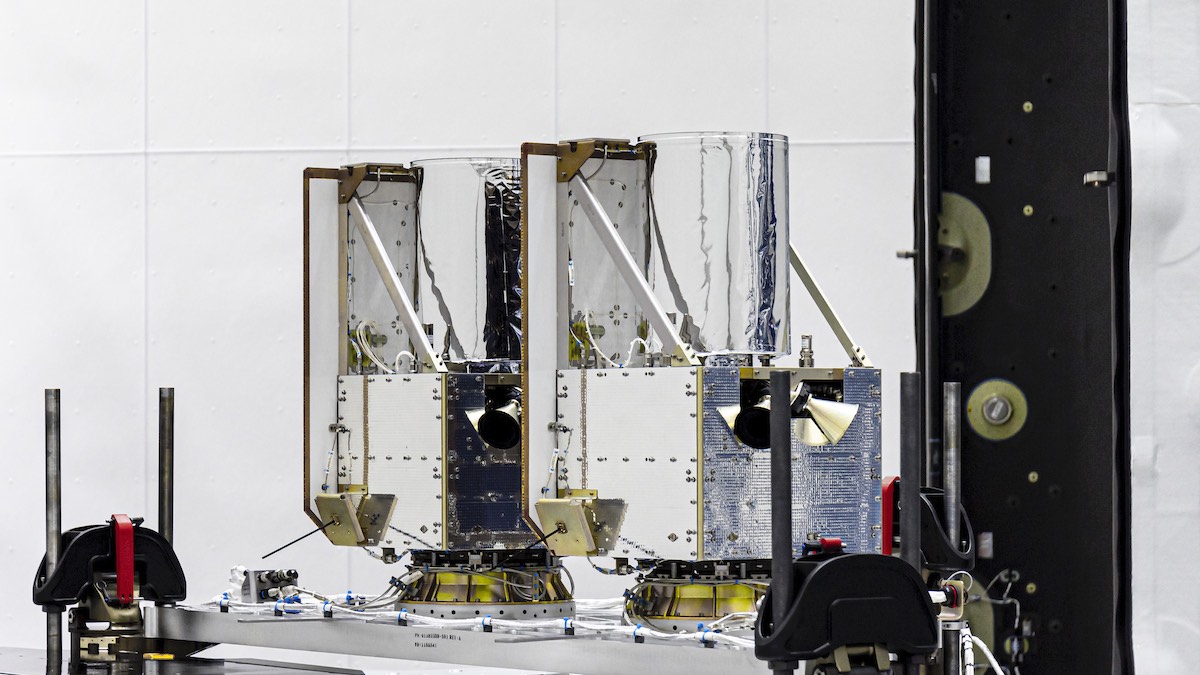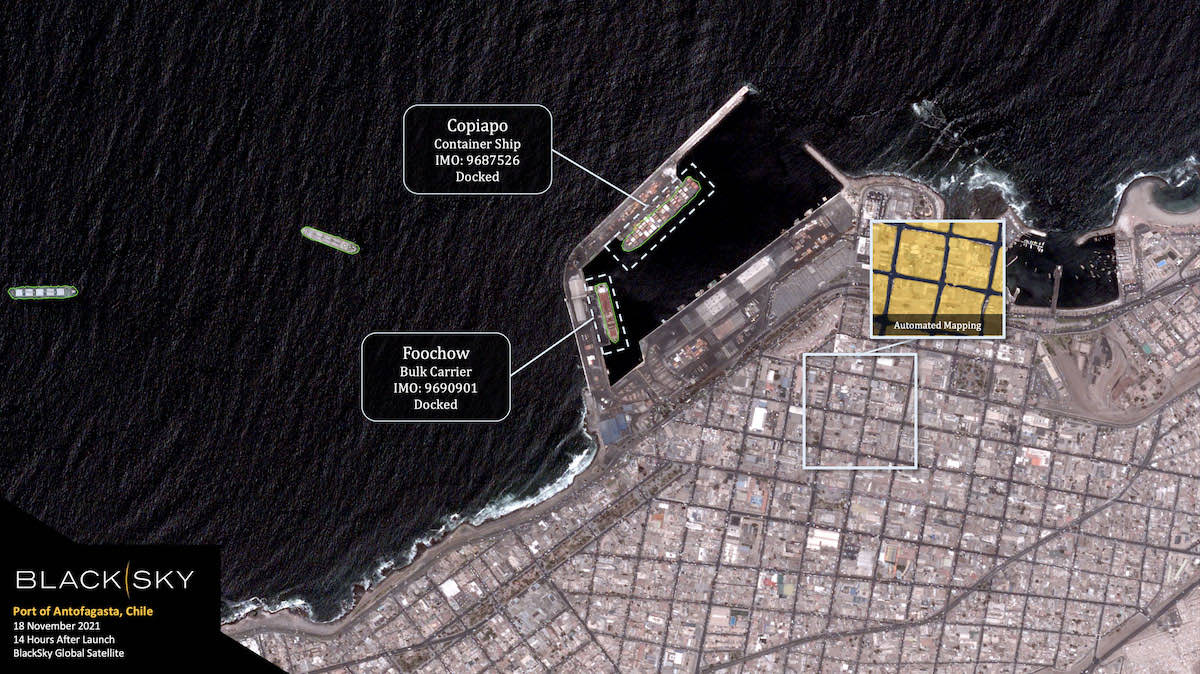Space News & Blog Articles
Two BlackSky satellites hitching ride on SpaceX Starlink mission
 A Falcon 9 rocket stands on pad 40 at Cape Canaveral Space Force Station this week in preparation for SpaceX’s next Starlink mission. Credit: Stephen Clark / Spaceflight Now
A Falcon 9 rocket stands on pad 40 at Cape Canaveral Space Force Station this week in preparation for SpaceX’s next Starlink mission. Credit: Stephen Clark / Spaceflight Now
BlackSky said Tuesday it is launching two optical Earth observation satellites as rideshare payloads on a SpaceX Starlink mission planned for liftoff this week from Cape Canaveral. The mission is set for launch Thursday, one day later than the previous schedule.
The rideshare mission will mark the second time BlackSky satellites have hitched a ride into orbit on a SpaceX Starlink launch. In August 2020, two BlackSky spacecraft took off from Cape Canaveral aboard a Falcon 9 rocket with 57 Starlink satellites.
The two Earth-imaging microsatellites, each weighing around 121 pounds (55 kilograms), will launch on top of a stack of Starlink internet satellites inside the payload shroud of a Falcon 9 rocket.
SpaceX rolled the Falcon 9 launcher Monday to pad 40 at Cape Canaveral Space Force Station and raised the rocket vertical in preparation for a hold-down test-firing. The static fire was initially expected Monday or Tuesday for a launch attempt Wednesday evening, but the test did not happen.
Three sources said Tuesday that SpaceX delayed the mission, which the company has designated Starlink 4-3, until no earlier than Thursday at 6:28 p.m. EST (2328 GMT). An airspace warning notice associated with the launch opportunity Wednesday was also canceled, leaving in place a temporary flight restriction around the launch area for Thursday evening.
Spaceflight, a Seattle-based company, is managing the rideshare launch service for BlackSky.
 File photo of two BlackSky Earth-imaging satellites inside a SpaceX processing facility at Cape Canaveral last year. Credit: SpaceX
File photo of two BlackSky Earth-imaging satellites inside a SpaceX processing facility at Cape Canaveral last year. Credit: SpaceX
The two new BlackSky satellites will join eight others in the BlackSky fleet. Two BlackSky satellites launched Nov. 17 on a Rocket Lab mission from New Zealand, and Rocket Lab plans another launch in December carrying two more BlackSky payloads.
Expanding the constellation “will enhance the company’s geospatial capacity for data while increasing revisit rates for customers,” BlackSky said in a statement.
The surge of launches with BlackSky satellites, assuming they remain on schedule, will double the size of the company’s fleet from six to 12 spacecraft over a period of six weeks.
Another two BlackSky satellites are booked for launch on a Rocket Lab mission in 2022. The remote sensing company has ordered additional spacecraft from its manufacturer, LeoStella, based in Tukwila, Washington, a suburb of Seattle.
LeoStella is a joint venture between BlackSky and Thales Alenia Space, a major European satellite manufacturer.
BlackSky, with offices in Seattle and Herndon, Virginia, is deploying a fleet of small remote sensing satellites to provide high-resolution Earth imagery to commercial and government clients.
One big customer for BlackSky is the U.S. military and intelligence agencies. BlackSky has agreements to sell commercial imagery to NASA, the National Reconnaissance Office and the National Geospatial-Intelligence Agency.
BlackSky says the commercial market for its services include customers in transportation, infrastructure, construction, and supply chain management.
Each of the current generation of BlackSky Global spacecraft can capture up to 1,000 color images per day, with a resolution of about 3 feet (1 meter). In the future, BlackSky will deploy a third generation of BlackSky satellites with sharper resolution level of about 20 inches, or 50 centimeters.
The company uses artificial intelligence and machine learning algorithms to process and analyze imagery beamed back to Earth from BlackSky satellites. The algorithms and detect and identify objects in the images without humans in the loop, according to BlackSky.
After its last launch with Rocket Lab, BlackSky put its satellites through systems checkouts and started taking images. The automated image analysis system processed the first images within 14 hours of launch. BlackSky released a view of a port in Antofagasta, Chile, to demonstrate the company’s ability to rapidly activate and “operationalize” a satellite.
 A BlackSky remote sensing satellite captured this view of a port in Chile after launch on a Rocket Lab mission on Nov. 17. Credit: BlackSky
A BlackSky remote sensing satellite captured this view of a port in Chile after launch on a Rocket Lab mission on Nov. 17. Credit: BlackSky
“Growing BlackSky’s constellation and increasing our rapid-revisit monitoring capabilities is about more than just getting satellites into space,” said Nick Merski, BlackSky chief operations officer, in a statement. “The key value to customers is how quickly we incorporate data from these sensors into our AI architecture. It’s about the prompt delivery of top quality, automated services for insights that our customers can trust.”
SpaceX provides relatively low-cost rides to orbit to external customers by selling extra capacity on its Starlink missions. The launch company also launches dedicated rideshare flights, called Transporter missions, with dozens of small satellites from a range of U.S. and international customers.
According to SpaceX’s website, the company charges $1 million to launch a 440-pound (200-kilogram) satellite on a rideshare mission. That’s significantly lower than any other launch provider, including small satellite launchers like Rocket Lab’s Electron.
But Rocket Lab and other smallsat launch companies can satellites into orbit on dedicated rides, giving operators more flexibility to choose their altitude and inclination.
SpaceX will deploy the two BlackSky satellites into a 267-mile-high (430-kilometer) orbit at an inclination of 53 degrees, according to Spaceflight, the rideshare launch broker.
The Falcon 9 rocket will deploy its stack of Starlink payloads after releasing the BlackSky satellites. SpaceX has not said how many Starlink satellites are on-board the mission set for launch this week.
The previous Starlink mission Nov. 13, which kicked off deployment of a new phase of the Starlink network, carried 53 satellites, all with inter-satellite laser links. It was not clear Tuesday whether the addition of the BlackSky satellites will reduce the number of Starlink spacecraft carried on the next mission.
This email address is being protected from spambots. You need JavaScript enabled to view it. the author.
Follow Stephen Clark on Twitter: @StephenClark1.
When you subscribe to the SpaceZE News Feed, we will send you an e-mail when there are new updates on the site so you wouldn't miss them.

